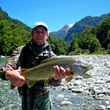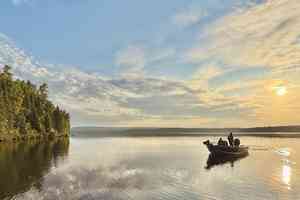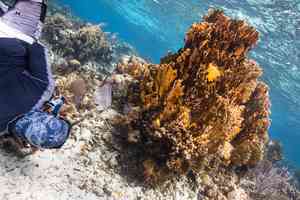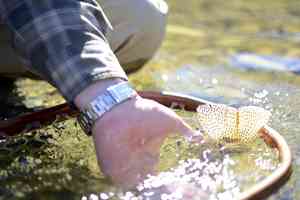In recent years, steelhead populations along the west coast of the United States have continued to dwindle. 2019 was another dismal year for steelhead returns throughout the Pacific Northwest, sparking fishing closures, with the usual suspects to blame—poor ocean conditions caused by marine heatwaves, the impacts of hatchery fish on wild populations and, of course, habitat degradation and the myriad other impacts of dams on watersheds that are historically home to anadromous fish.
But, as documented in Trout Unlimited's new film Rising from the Ashes, one river, Washington's Elwha, has been an outlier. The fact that it is the Elwha River that has bucked the coast-wide trend is no small matter. The river was a longtime mantlepiece of dam removal advocates and, since the last pieces of its two dams were removed in 2014, it has become a living laboratory for hydrologists, marine and fish biologists, river morphologists and anyone else interested how dam removal aids river restoration.
Historically, the Elwha was a vibrant river with robust runs of wild steelhead and all five species of pacific salmon. But, the construction of two dams in the early 1900s—the Glines Canyon and Elwha dams—blocked passage to 38 miles of the upper river and dramatically degraded the river's habitat. For over 100 years, salmon and steelhead below the dams lacked access to critical up-river spawning habitat and the fish above the dams were landlocked, completely cutoff from the ocean. Salmon returns dwindled from 400,000 to 4,000. Steelhead returns fizzled to almost nothing, with Elwha summer-run steelhead believed to possibly be extinct.
But, according to a team of scientists who recently surveyed the river, the Elwha's steelhead are back. And not simply back—just a few short years after the Elwha's dams, the Elwha's summer-run returns are now believed to be the largest on the entire Washington coast.

When the Elwha's dams were finally removed, for the first couple of years, the river spent its time flushing to the ocean a century's worth of sediment that collected in manmade Lake Aldwell and Lake Mills. The USGS estimates that 33 million tons of sediment—enough that it would take more than 70 dump trucks running 24 hours a day for five years to move that much dirt, rock and wood—was flushed downstream. The Elwha River delta, which had been sediment-starved for over 100 years, was reborn. Five years later, the USGS reported that the Elwha River delta continued to transform.
Initial estimates by fisheries biologist suggested that it would take 15-20 years for the Elwha to return to pre-dam conditions. Some estimated it would take as long as the 100 years that the river was dammed for steelhead to re-establish their presence in the Elwha. But researchers counted over 300 summer-run steelhead in the uppermost 15 miles of the Elwha alone—an accomplishment that is credited solely to the fish themselves, as no hatchery augmentation has been a part of the summer-run steelhead restoration efforts. In all, it is estimated that almost 1,000 wild steelhead returned to the Elwha in 2019. This rapid return of the Elwha's wild steelhead has served as both a surprise and an inspiration for the immense list of collaborators that have made the river's restoration a reality.
John McMillan, Science Director of Trout Unlimited’s Wild Steelhead Initiative told Hatch Magazine “I must admit that the rapid resurgence has been surprising, even for a species like steelhead that displays so much diversity and resilience. Swimming through three miles of box-canyon and observing over 100 adult wild steelhead was truly special. I couldn’t believe it. But I shouldn’t have been so surprised. There were thousands upon thousands of rainbow trout locked above the dams and research indicates that many rainbow trout will forever retain their ability to smolt and migrate to the ocean and become a steelhead. In this case, all we had to do was remove the dams and allow anadromy to re-awaken. Perhaps more importantly though, the experience brought tangible proof that dam removal can work. This is not a modeling exercise or a prediction. It is real life. And the reality suggests that recovering species like summer steelhead, that rely on headwater habitats, will depend on restoring access to their former habitats. I can’t wait to see what the next four to five years bring in the Elwha. At this point, anything is possible. As a scientist and conservationist, that is a wonderful feeling.”


"The story of Elwha should be a beacon of hope for dam removals all over the world. This is just one more example that we should never underestimate the power and complexities of nature," Rising from the Ashes filmmaker Shane Anderson said.
For the full story—including some dramatic footage of the beautiful Elwha River basin and its wild fish—sit down with the short, 10-minute film Rising from the Ashes.





























Comments
Pete Soverel replied on Permalink
It is critical to distinguish between the rapid recovery of wild summer run steelhad and the compmlet lack of response on the part of wild winter steelhead. In the case of the former, the recovery is based 100% on natural recovery from existing wild fish. The recovery strategy for winter runs is dependent on artificial progagation which has been a complete failure. Recovery of Elwha Chinook is based upon massive infusion of hatchery reared juveniles (5 million an year). Similar to the hatchery based steelhead program, Chinook are not coloonizing the upper river. In my view the only beneficiaries of the hatchery based Chinook and winter steelhead recovery programs has been to feed the scores of thousands of birds, seals, black fish, dog fish, etc. which flock to the Elwha estuary for the free lunch. Wild summer runs know what to do and are doing it. The hatchery fish don't and aren't. Close the hatchery programs. Not only are they a gigantic waste of money, they are prevenint rocovery of wild stocks.
mark mc myn replied on Permalink
In this day and age, it is impossible,but just imagine if they removed the columbia river dam! The triumphant return of the elwha summer steelhead is testimony to the strength of this champion of fish!
Pages